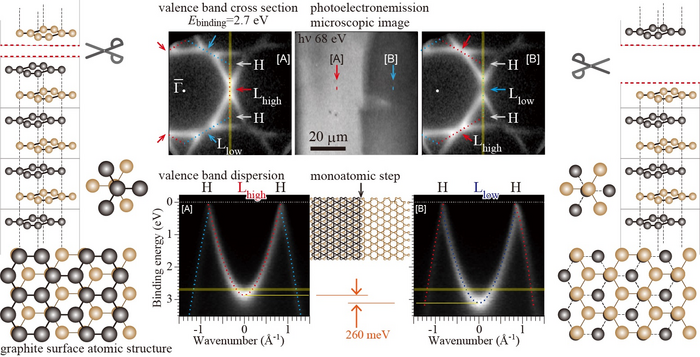Graphite is a very significant and adaptable material with applications in many different sectors. As graphite is able to withstand high temperatures and easily conduct electricity, it is particularly important for electronics.
 Graphite surface microscopic image and valence band structure together with atomic structure models. Image Credit: Fumihiko Matsui, Institute for Molecular Science in Okazaki, Japan
Graphite surface microscopic image and valence band structure together with atomic structure models. Image Credit: Fumihiko Matsui, Institute for Molecular Science in Okazaki, Japan
Many batteries, especially lithium-ion batteries, require graphite as a vital component, and demand is only rising as new technologies are adopted. For instance, the manufacture of batteries and the need for graphite will expand as a result of solar energy and electronic cars.
Graphite has been intensively studied for decades, yet there is still more that can be learned. Surprisingly, no spectroscopic studies have been able to precisely determine the electronic states of the graphite surface and edge from a microscopic perspective up until now.
This is significant as the management of the properties of the graphite at the tip is a key factor in improving battery performance.
Researchers used a newly designed photoelectron spectroscopy machine coupled with an electron microscope to describe fresh observations of the surface state of graphite in a study published on 21st June 2022 in Physical Review B.
In this study, we report the microscopic observation of three-fold symmetric graphite surface states coupled with bulk kz dispersed π bands. The finding highlights the relevance of considering surface effects in bulk intrinsic electronic state measurements. The question we address is: how accurate can we measure the intrinsic bulk kz dispersion?
Fumihiko Matsui, Professor, Institute for Molecular Science
Energy bands are found in what is referred to as a band structure in crystalline formations like graphite. The surface state refers to the particular electronic structure that exists on the material’s surface in addition to the intrinsic bulk band structure.
Macroscopic measurements frequently average and fail to distinguish the numerous tiny surface characteristics. The worst-case scenario for this conventional measurement technique is that it can lead to surface states being ignored and bulk-specific electronic properties being misinterpreted.
Researchers examined the electrical structures of the graphite surface using a method called photoelectron momentum-resolved spectro-microscopy. They were successful in photographing single-atom height steps on a graphite surface and were able to observe how the surface states interacted with the bulk bands.
Researchers can gain a better understanding of graphite’s electrical characteristics by comprehending both its surface state and band structures.
Graphite is a crystalline form of carbon with several layers. Graphene, the name for each layer of graphite, has a hexagonal honeycomb structure. The kind of electrical band structures seen in graphite depends on how these layers are stacked on top of one another.
Matsui added, “Graphite crystals with an ABAB-type stacking structure are six-fold symmetric around the z axis, whereas a surface with one type of termination is three-fold symmetric.”
The combination of this six-fold structure with the three-fold structure decreased the band’s degeneracy and lowered symmetry, according to studies into the dispersion of the kz band at the micrometer scale.
In this study, we have succeeded in characterizing the effect of such a coupling in a surface geometry with broken symmetry. The observed bulk dispersion differs from the discrete electronic states of several layers of graphene, meaning that the measurement is also sensitive to the bulk electronic states from much deeper than the mean free path length of the emitted electrons.
Fumihiko Matsui, Professor, Institute for Molecular Science
He further stated, “Moreover, the kz dispersion bandwidth is affected by the coupling with the surface electronic state, as shown in this study. The accuracy and resolution of kz dispersion bandwidth determination are limited by the electron attenuation length, especially when the surface resonance state couples with the bulk kz-dispersed band.”
Future theoretical studies are required to comprehend how these various structures interact.
Matsui concluded, “Further theoretical studies of valence photoelectron emission with precise consideration of the surface effect are desired in order to clarify the kz intensity dependence.”
This study also included contributions from Shigemasa Suga of SANKEN, Osaka University.
Journal Reference:
Matsui, F., et al. (2022) Coupling of kz-dispersing π band with surface localized states in graphite. Physical Review B. doi:10.1103/PhysRevB.105.235126